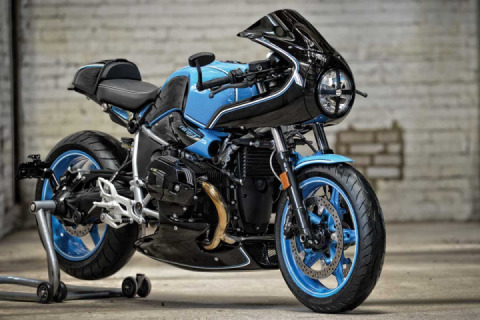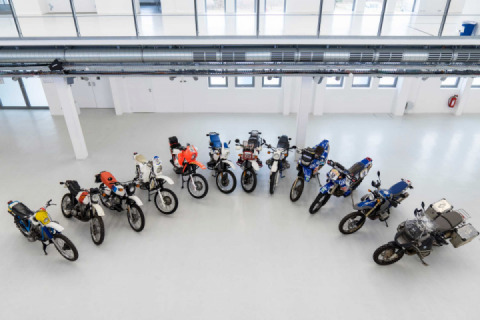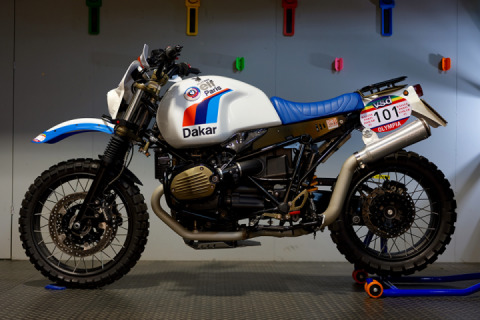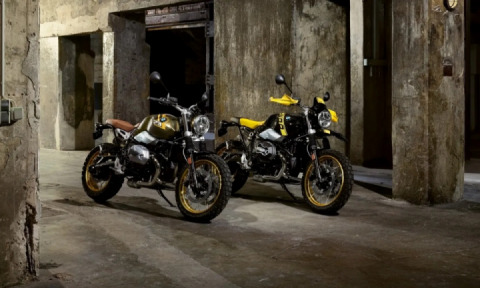
NMOTO Recreates The Sexiest BMW R nineT R7
“I was lucky enough to be at Pebble Beach for the unveiling of the restored 1934 R7 in 2012,” says NMOTO founder Alex Niznik. “Being so close to a piece of history that never reached its full potential gave me direction. I fell in love with the motorcycle, and made a promise to myself that when I retired at the age of 55, I would look into building a motorcycle like that. I founded NMOTO a few years later and began developing the Nostalgia Project to capture that same innovation and breathe new life into a vintage design.” BMW created the R7 in 1934, an Art Deco masterpiece that never entered production. Dismantled and stored along with its blueprints, the R7 was rediscovered more than 70 years later. BMW Classic completed its restoration and at the 2012 Pebble Beach Concours it took top honors in Class X for German motorcycles, besting a 1954 BMW R68 and a 1968 Münch Mammoth.
BMW created the R7 in 1934, an Art Deco masterpiece that never entered production. Dismantled and stored along with its blueprints, the R7 was rediscovered more than 70 years later. BMW Classic completed its restoration and at the 2012 Pebble Beach Concours it took top honors in Class X for German motorcycles, besting a 1954 BMW R68 and a 1968 Münch Mammoth.
 “Our goal was a bike that combined vintage aesthetics with modern technology. Stanislav Pavlov, who worked with famous builders Jimmy Shine and John Beck, leads our team of metal shapers, engineers, and designers. We wanted something that was more than just a pretty collection piece, but a motorcycle that you can actually ride comfortably on a daily basis, says Niznik.” In this regard, NMOTO is a wildly entrepreneurial and ultra-low-volume variation on the reborn Indians created by Polaris. The main difference is NMOTO did not have the depth of Polaris, which had already developed its Victory line and could invest in a unique and carefully stylized V-twin engine, gearbox and chassis. With emphasis on styling and not engineering, NMOTO only needed to elaborate from a proven motorcycle.
“Our goal was a bike that combined vintage aesthetics with modern technology. Stanislav Pavlov, who worked with famous builders Jimmy Shine and John Beck, leads our team of metal shapers, engineers, and designers. We wanted something that was more than just a pretty collection piece, but a motorcycle that you can actually ride comfortably on a daily basis, says Niznik.” In this regard, NMOTO is a wildly entrepreneurial and ultra-low-volume variation on the reborn Indians created by Polaris. The main difference is NMOTO did not have the depth of Polaris, which had already developed its Victory line and could invest in a unique and carefully stylized V-twin engine, gearbox and chassis. With emphasis on styling and not engineering, NMOTO only needed to elaborate from a proven motorcycle.
 NMOTO Nostalgia is based on a current BMW R Nine T, a bike that can legitimately claim DNA that reaches to the earliest BMW opposed twin bikes, like the original R7, an unbroken evolutionary chain. Bear in mind that current BMW two-cylinder bikes are a mainstay of U.S. police and highway patrol thanks to their smooth power, excellent handling, and all-day comfort. The R Nine T’s 1170cc two-cylinder produces 86 lb-ft of torque, enough to push Nostalgia to 140 mph. As a former engineering colleague and long-time friend of mine says, “The BMW is an engineer’s bike.”
NMOTO Nostalgia is based on a current BMW R Nine T, a bike that can legitimately claim DNA that reaches to the earliest BMW opposed twin bikes, like the original R7, an unbroken evolutionary chain. Bear in mind that current BMW two-cylinder bikes are a mainstay of U.S. police and highway patrol thanks to their smooth power, excellent handling, and all-day comfort. The R Nine T’s 1170cc two-cylinder produces 86 lb-ft of torque, enough to push Nostalgia to 140 mph. As a former engineering colleague and long-time friend of mine says, “The BMW is an engineer’s bike.”
 “We didn’t modify the factory R Nine T powertrain. BMW creates a great motorcycle for the world of custom builds—all the parts are bolts-on. We used original points to fasten the body to the frame. For the rear fender, we created a special rod because the stock rear fender on BMW R Nine T is connected to the seat. Only the rear sub-frame was modified for our final design to emulate the BMW R7.” Unlike debatable custom bikes that use S&S Harley clone engines and engineering informed more by fantasy than function, NMOTO retains all the excellence, durability and reliability of the BMW chassis and powertrain.
“We didn’t modify the factory R Nine T powertrain. BMW creates a great motorcycle for the world of custom builds—all the parts are bolts-on. We used original points to fasten the body to the frame. For the rear fender, we created a special rod because the stock rear fender on BMW R Nine T is connected to the seat. Only the rear sub-frame was modified for our final design to emulate the BMW R7.” Unlike debatable custom bikes that use S&S Harley clone engines and engineering informed more by fantasy than function, NMOTO retains all the excellence, durability and reliability of the BMW chassis and powertrain.
 “Rather than just recreating the 1934 BMW R7 model,” says Niznik, “we brought it into the new world with power and performance it could not achieve when it was first introduced. By using the heritage BMW R Nine T as a base, we were able to maintain the integrity of our inspiration while still making it our own.” Choosing the R7, a mythological creature from the ancient past, and building upon its 21st Century successor, is a true stroke of product planning genius. BMW used James Bond movies to market its attempt at an American-style cruiser bike, and that bike failed, an ungainly piece. But here we find true beauty.
“Rather than just recreating the 1934 BMW R7 model,” says Niznik, “we brought it into the new world with power and performance it could not achieve when it was first introduced. By using the heritage BMW R Nine T as a base, we were able to maintain the integrity of our inspiration while still making it our own.” Choosing the R7, a mythological creature from the ancient past, and building upon its 21st Century successor, is a true stroke of product planning genius. BMW used James Bond movies to market its attempt at an American-style cruiser bike, and that bike failed, an ungainly piece. But here we find true beauty. “Nostalgia is not just a one-off custom motorcycle,” says Niznik. “It’s a production motorcycle that incorporates traditional old-fashion metal-shaping. We are using different CNC machinery for milling, laser works, engraving, etc. You need a big fleet of different machinery. Nostalgia consists 96 handcrafted pieces, including about 74 parts built by NMOTO. An all-new gas tank, throttle system, fenders mounts, brackets, wires, etc.”
“Nostalgia is not just a one-off custom motorcycle,” says Niznik. “It’s a production motorcycle that incorporates traditional old-fashion metal-shaping. We are using different CNC machinery for milling, laser works, engraving, etc. You need a big fleet of different machinery. Nostalgia consists 96 handcrafted pieces, including about 74 parts built by NMOTO. An all-new gas tank, throttle system, fenders mounts, brackets, wires, etc.”
 “It took about four months to design Nostalgia, another four months for the three in-house engineers to define the build in SolidWorks. Fabrication of the first bike took seven months due to interplay of craftsmen and engineer.” NMOTO fully leverages the power of these readily available software systems, allowing a tiny company to punch far above its weight.
“It took about four months to design Nostalgia, another four months for the three in-house engineers to define the build in SolidWorks. Fabrication of the first bike took seven months due to interplay of craftsmen and engineer.” NMOTO fully leverages the power of these readily available software systems, allowing a tiny company to punch far above its weight.
 “Aluminum is not a simple material to work with. There is almost no chance for mistakes or you will start from the beginning,” says Niznik. “We employ old-fashion metal shaping as well as CNC machinery. Each Nostalgia motorcycle has its own hand-built body, no stamps at all. Panels are handmade through wood frame, as it should be, using an English Wheel and Power Hummer.
“Aluminum is not a simple material to work with. There is almost no chance for mistakes or you will start from the beginning,” says Niznik. “We employ old-fashion metal shaping as well as CNC machinery. Each Nostalgia motorcycle has its own hand-built body, no stamps at all. Panels are handmade through wood frame, as it should be, using an English Wheel and Power Hummer.
 Even though NMOTO deliberately did not modify any of the mechanical parts beyond the throttle system, BMW warranties are void. But perhaps NMOTO can negotiate with BMW board member Peter Schwarzenbauer, who manages Motorrad, Rolls, MINI and iVentures, to gain BMW’s blessing. I’d be surprised if BMW didn’t commission one of these bikes and take it back to Munich for a once-over. It’s a brilliant cruiser alternative to Harley, Indian and Yamaha Star.
Even though NMOTO deliberately did not modify any of the mechanical parts beyond the throttle system, BMW warranties are void. But perhaps NMOTO can negotiate with BMW board member Peter Schwarzenbauer, who manages Motorrad, Rolls, MINI and iVentures, to gain BMW’s blessing. I’d be surprised if BMW didn’t commission one of these bikes and take it back to Munich for a once-over. It’s a brilliant cruiser alternative to Harley, Indian and Yamaha Star.
 By starting with a BMW Motorrad bike with such high levels of engineering integrity and a logical modular build system, Niznik starts off at very close to parity with Harley, Indian, and the Japanese. Excepting the throttle system, mechanical components are not modified, which means BMW quality. It’s extraordinary to think no one else has pursued this avenue. Polaris became Harley’s first great challenger with its reborn Indian lineup—the Chiefs look like they have teleported from 1952. Without getting caught up in engineering their own engine and gearbox, NMOTO has become immediately relevant with a nostalgic cruiser for $49,500.
By starting with a BMW Motorrad bike with such high levels of engineering integrity and a logical modular build system, Niznik starts off at very close to parity with Harley, Indian, and the Japanese. Excepting the throttle system, mechanical components are not modified, which means BMW quality. It’s extraordinary to think no one else has pursued this avenue. Polaris became Harley’s first great challenger with its reborn Indian lineup—the Chiefs look like they have teleported from 1952. Without getting caught up in engineering their own engine and gearbox, NMOTO has become immediately relevant with a nostalgic cruiser for $49,500.
 At any coastal watering hole from San Diego to Laguna to Malibu, an NMOTO will stand apart. Thanks to the integrity design and metal work, curbside and tavern conversations will start easily.
At any coastal watering hole from San Diego to Laguna to Malibu, an NMOTO will stand apart. Thanks to the integrity design and metal work, curbside and tavern conversations will start easily.



Credit:forbes.com
#Moto #Bike #BMW #RnineT #Custom





























